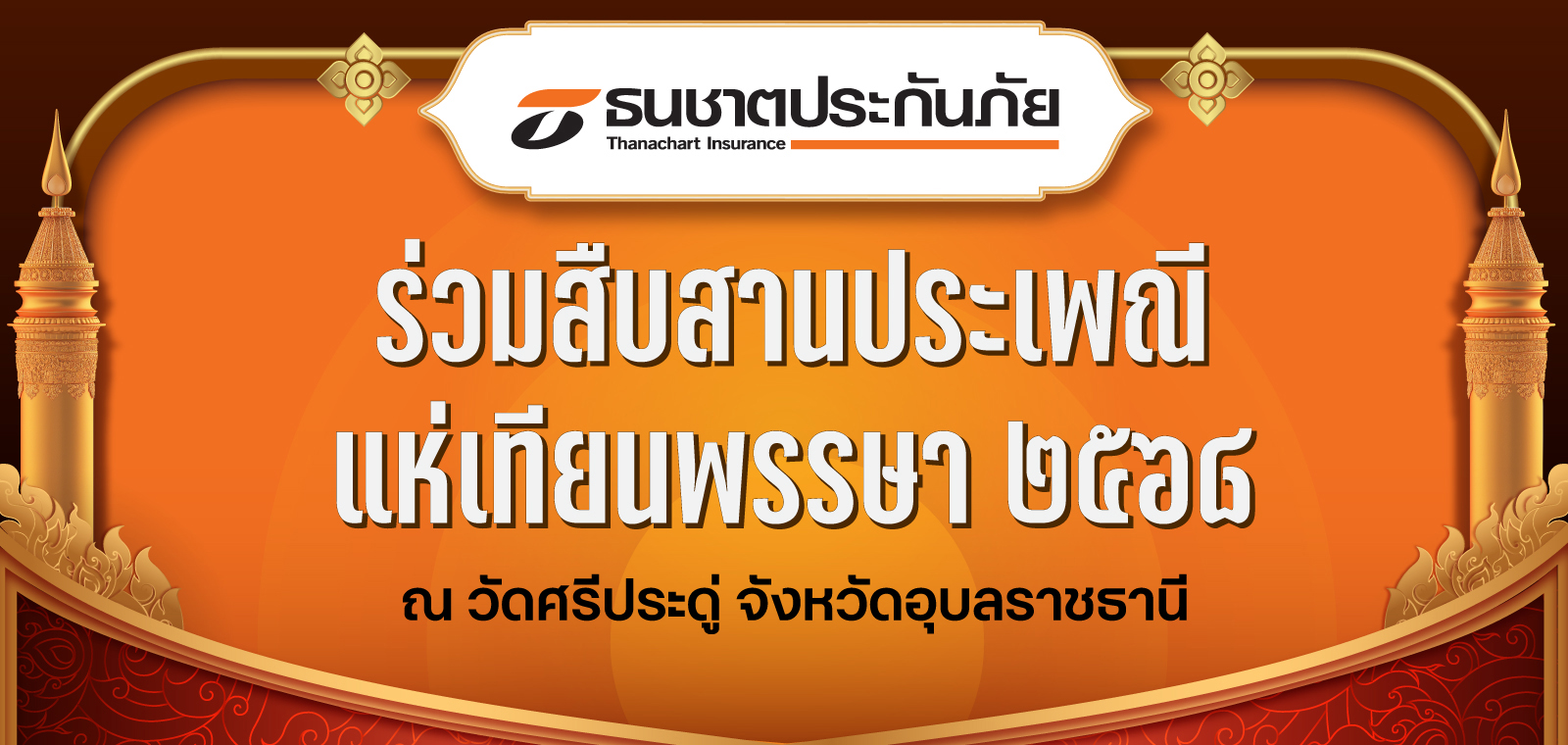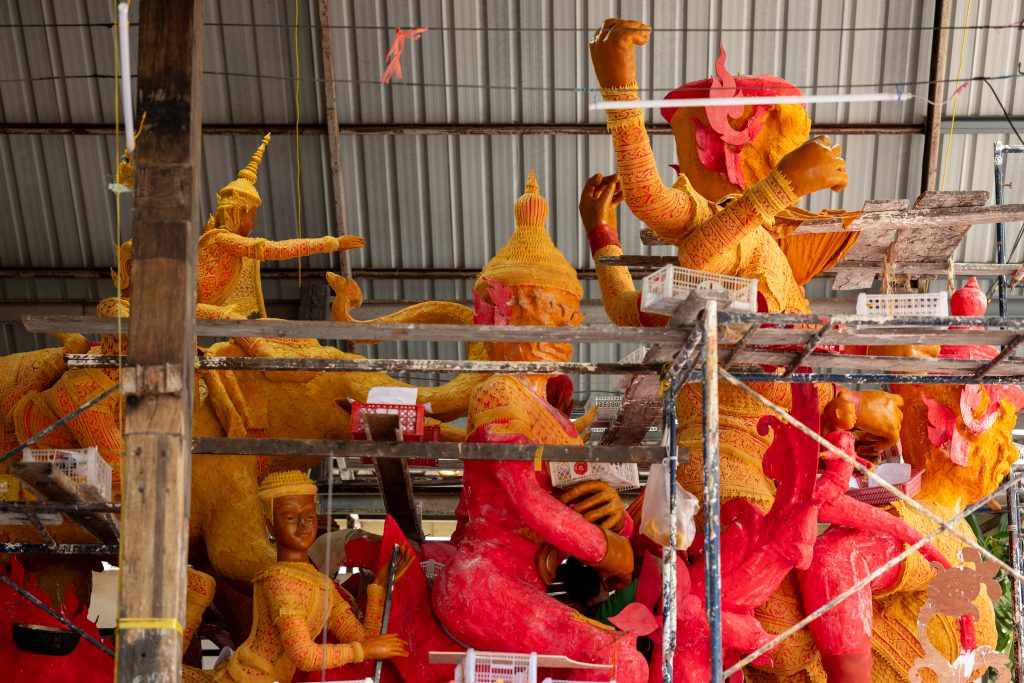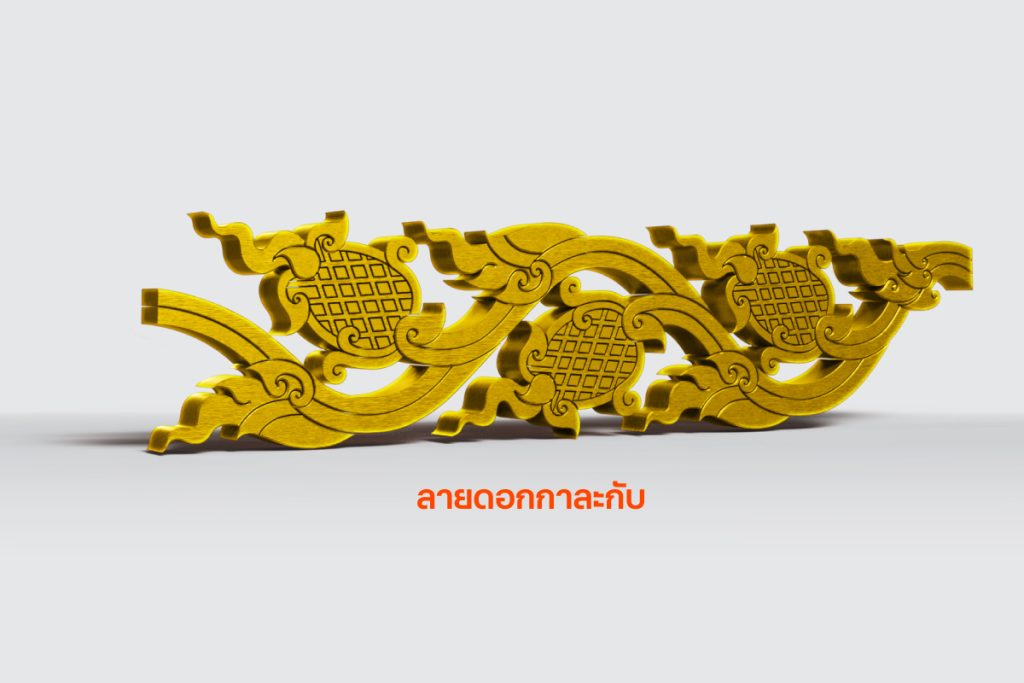
นำเสนอแนวคิด "การต่อสู้ระหว่าง “ความดี” และ “ความชั่ว" โดยถ่ายทอดผ่านเหตุการณ์สำคัญในพุทธประวัติ ตอน มารผจญ เรื่องราวเริ่มขึ้นเมื่อเจ้าชายสิทธัตถะ บำเพ็ญเพียรจนถึงจุดสุดท้ายใต้ต้นพระศรีมหาโพธิ์ ท่ามกลางความเงียบสงัดของราตรีแห่งการตรัสรู้
พญามาร ชื่อ ท้าววสวัตตีมาร นั่งช้างคีรีเมขล์ พร้อมไพร่พลเสนากองทัพมาร และธิดาทั้งสาม ได้แก่ ตัณหา ราคา และอรดี ได้ออกมาขัดขวางการตรัสรู้ของพระพุทธองค์ ได้ออกมาขัดขวางเจ้าชายผู้มุ่งสู่การเป็นพระพุทธเจ้า แต่ไม่สำเร็จพ่ายแพ้กลับไป

พญามาร ชื่อ ท้าววสวัตตีมาร ยืนออกหน้า และอีกหนึ่งร่างนั่งช้างคีรีเมขล์ พร้อมไพร่พลทัพมาร และมีพญานาคคดเคี้ยวไปมาที่เปรียบเสมือนสายน้ำแห่งบุญบารมีอันศักดิ์สิทธิ์ ที่ไหล มาจากพระแม่ธรณีที่บีบมวยผม จนกองทัพมารพ่ายแพ้
ปลาคาบพญาครุฑรองรับต้นเทียน ด้านข้างเป็นพระแม่ธรณีบีบมวยผมเป็นสายน้ำ ซึ่งเป็นต้นเทียนเหลี่ยมย่อมุมไม้สิบสอง ความสูงฐานถึงยอด 3 เมตร 40 เซนติเมตร เส้นผ่านศูนย์กลาง 80 เซนติเมตร
องค์สมเด็จพระพุทธสัมมาสัมพุทธเจ้าประทับบนรัตนบัลลังก์ มีธิดาพญามารแสดงท่ายั่วยวนบนวงแห่งวัฏสงสาร

.
คณะช่างทำเทียนวัดศรีประดู่ยึดมั่นในเจตนารมณ์ที่จะ สืบสานงานศิลปะพื้นถิ่นของอุบลราชธานี ผ่านต้นเทียนประจำปี พ.ศ. 2568 โดยให้ความสำคัญกับการส่งต่อภูมิปัญญาทางศิลป์จากรุ่นสู่รุ่น ควบคู่กับการสร้างแรงบันดาลใจให้คนรุ่นใหม่ได้เข้าถึงวัฒนธรรมในรูปแบบที่ร่วมสมัย ลวดลายที่ประดับติดบนต้นเทียนประกอบด้วยลวดลายไทย เช่น ลายกนกก้านขดหัวหงส์ ลายประจำยาม ลายรักร้อย ลายเกลียวใบเทศ ลายดอกกาละกับ และลวดลายอื่นๆ อีกมากมาย
ในปีนี้ เราได้เลือกใช้ “ลายดอกกาละกับ” ลวดลายดอกไม้โบราณที่มีรากเหง้าในศิลปะสกุลช่างล้านช้าง ซึ่งพบมากในงานไม้แกะสลักของวัดสำคัญในเมืองอุบล ลวดลายนี้มีจุดเด่นที่ “โครงสร้างของต้นไม้เป็นรูปหางไหลคล้ายตัว S เป็นแกนกลาง” มีการเลื้อยโค้งรับส่ง ปลายกิ่งออกช่อเป็น ดอกกาละกับ อ่อนช้อยงดงาม
ลายนี้มีความซับซ้อนในความสมดุล เช่น ด้านขวามือของหน้าบันหอไตรวัดทุ่งศรีเมือง มีการซ้อนขัดกันของกิ่งก้านแบบพลิ้วไหว ต่างจากด้านซ้ายที่เรียบง่าย สะท้อน “ความสมดุลแห่งศิลป์และชีวิต”
ดอกกาละกับ ยังปรากฏในงานสถาปัตยกรรมศักดิ์สิทธิ์ เช่น หอพระบาท บานประตูพระอุโบสถวัดมณีวนาราม วัดสุปัฏนารามวรวิหาร รวมถึงวัดศรีอุบลรัตนาราม ซึ่งสะท้อนให้เห็นว่า ดอกกาละกับมิใช่เพียงลวดลาย แต่คือสัญลักษณ์แห่งรากวัฒนธรรมล้านช้าง ที่ฝังแน่นในใจของช่างศิลป์อีสาน
เราจึงนำ ดอกกาละกับ มาประยุกต์กับเรื่องราวพุทธประวัติตอน "มารผจญ" บนลำต้นเทียน ทั้งในเชิงสัญลักษณ์และองค์ประกอบศิลป์

นอกจากนี้ เรายังได้นำแรงบันดาลใจจาก “ธรรมาสน์สิงห์บ้านชีทวน” ซึ่งตั้งอยู่ในศาลาการเปรียญวัดศรีนวลแสงสว่างอารมณ์ — ผลงานประติมากรรมอิฐถือปูนที่มีสิงห์ยืนเทินบุษบกประดับกระจกสี สร้างขึ้นโดย ช่างญวนผสมช่างพื้นถิ่นระหว่าง พ.ศ. 2468–2470 เป็นรูปแบบศิลปะผสมผสานพุทธมหายาน ไตรภูมิ และชาดก จนกลายเป็นผลงานศิลป์ท้องถิ่นที่มีหนึ่งเดียวในโลก
เราจึงได้นำโครงสร้างและจิตวิญญาณของธรรมาสน์นี้ มาประยุกต์ใช้ในช่วงท้ายของรถต้นเทียน เพื่อสะท้อนความหลอมรวมของศิลปะ วัฒนธรรม และศรัทธาที่ฝังรากลึกในอีสาน
ในขณะเดียวกัน คณะช่างยังได้นำเสนอความร่วมสมัย ผ่าน ท่วงท่าของธิดามารทั้งสาม ที่ถูกออกแบบให้มีลีลานำสมัย แปลกตา แต่ยังคงไว้ซึ่งความอ่อนช้อยสอดคล้องกับเนื้อหาโดยรวมของต้นเทียน โดยใช้เทคนิคติดพิมพ์ลายโบราณเพื่อสร้างความลุ่มลึกและทรงคุณค่าทางสายตา
การผสมผสานระหว่าง ศิลปะดั้งเดิมกับความร่วมสมัยนี้ ไม่เพียงเป็นการแสดงออกถึงความเคารพในรากเหง้าเท่านั้น หากยังเป็นความหวังที่เราคณะช่างมีร่วมกันว่า “จะเป็นสะพานเชื่อมให้คนรุ่นใหม่ได้ใกล้ชิดและภาคภูมิใจในศิลปะวัฒนธรรมของตนเอง”
The lent candle sculpture presents the profound concept of “the battle between “good deeds” and “bad deeds” told through a pivotal moment in the life of the Buddha — the episode of Māra’s Temptation. This powerful narrative begins when Prince Siddhattha engages in intense ascetic practices, arriving at the final moment of his spiritual journey beneath the Bodhi tree, in the deep silence of the night of enlightenment.
Māra, named in full as Vassavattī Māra, mounts his celestial elephant Girimēkhala, leading an army of demons and his three seductive daughters: Taṇhā (Craving), Rāga (Passion), and Aratī (Aversion). Their goal was to obstruct the prince's path to Buddhahood but Māra is ultimately defeated.
Vassavattī Māra takes center stage, and another separated body mounted on his elephant, Girimēkhala, leading his fearsome Māra’s army. Winding through the composition is the mythical Nāga symbolizing the sacred currents of spiritual merit. These streams originate from Phra Māe Thorani, the Earth Goddess, who wrings torrents of water from her hair to drown Māra’s army.
A mythical fish holds a Garuḷa supporting the candle base, while the side of the candle representing Phra Māe Thorani continues to wring the flood of merit from her hair. The lent candle body itself takes the form of a traditional twelve-cornered stepped pillar, standing 3.4 meters tall with a diameter of 80 centimeters.
The Buddha is seated serenely upon the Jewel Throne, surrounded by Māra’s daughters performing seductive dances within the Wheel of Samsāra.
.
.
The artisans of Wat Si Pradu are firmly committed to preserving the traditional folk art of Ubon Ratchathani through the annual Lent candle. Their work emphasizes the transmission of artistic wisdom across generations, while simultaneously inspiring the youth to engage with culture in a modern, relatable way.
The candle is adorned with intricate traditional Thai motifs such as Kanok Kan Khod Hua Hong (flame scrolls with swan heads), Prajam Yam (geometric floral patterns), Rak Roi (interlocking vines), Kliao Bai Thet (twisted leaves), Dok Kalakap (ancient Kalakap flower motifs), and more.
For 2025, the artisans have chosen “Dok Kalakap motif” a flower pattern rooted in the Lan Xang art tradition, widely seen in wood carvings of prominent temples in Ubon Ratchathani. This motif is remarkable defined by “a tree-like structure, with S-shaped curves forming the central axis.” The branches gracefully coil, ending in delicate blossoms of Dok Kalakap reflecting elegance and fluidity.
Its artistic complexity lies in its balance — for example, the Dok Kalakap motif on the right side of the gable of Ho Trai (scripture library) at Wat Thung Si Muang, the flowing lines intertwine, while the left side remains simpler, symbolizing “the harmony of art and life.”
Dok Kalakap motif also appears in sacred architectural elements such as Ho Phra Bat (Footprint Shrine), the doors of the Ubosatha Hall at Wat Maneewanaram and Wat Supattanaram Worawihan, as well as Wat Si Ubonrattanaram. This illustrates represents that the motif is not merely decorative, but a cultural emblem deeply rooted in the Lan Xang culture and the hearts of Isaan artisans.
Therefore, The Dok Kalakap motif is appeared into the narrative of “Māra’s temptation”, in both symbolically and artistically.

Additionally, the team drew inspiration from the “Singha Pulpit of Ban Chi Thuan”, located in the sermon hall of Wat Si Nuan Saeng Sawang Arom. Created between 1925–1927 by Vietnamese and local artisans, the pulpit is a stucco structure featuring a standing Singha supporting a glass-inlaid canopy. It uniquely fuses Mahāyāna Buddhism, Traibhūmi (Three Worlds cosmology), and Jātaka tales — a truly singular expression of local sacred art in the world.
This sacred pulpit’s structure and spirit have been reimagined into the final portion of the lent candle procession, symbolizing the unification of art, culture, and faith deeply embedded in the Northeast of Thailand.
In parallel, the artisans introduced contemporary elements in the postures of Māra’s three daughters — their gestures are stylized and modern, yet remain graceful and in harmony with the overall narrative. Traditional print techniques are used to lend depth and visual richness to these figures.
This synthesis of tradition and modernity is not only a respect to traditional heritage but also a heartfelt hope that “This creation becomes a bridge connecting the younger generation with the pride and beauty of their art and culture.”